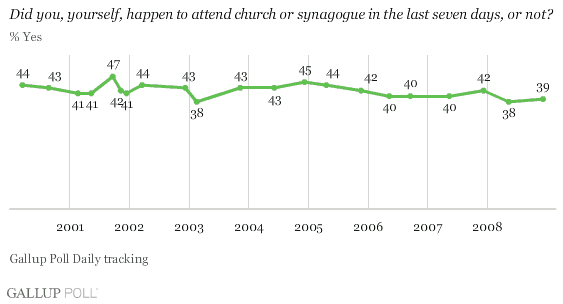PRINCETON, NJ -- Despite some news reports to the contrary, a review of almost 300,000 interviews conducted by Gallup so far in 2008 shows no evidence that church attendance in America has been increasing late this year as a result of bad economic times. In September, October, November, and so far in December, about 42% of Americans reported that they attended church weekly or almost every week, exactly the same as the percentage who reported attending earlier in the year.

A recent story in the New York Times, written by Paul Vitello, was headlined "Bad Times Draw Bigger Crowds to Churches," and reported that evangelical churches in particular had enjoyed a "burst of new interest" since September, but also that "a recent spot check of some large Roman Catholic parishes and mainline Protestant churches around the nation indicated attendance increases there, too." Producers for NBC's "Today" show picked up this New York Times story, and it became the basis for a similarly themed feature broadcast on that show on Dec. 16.
It may be true that some evangelical churches, such as those whose leaders were interviewed in the New York Times article, have enjoyed big increases in attendance this fall as the economic crisis has worsened. But a review of Gallup Poll Daily tracking data, in which 1,000 randomly selected people each day are asked how often they attend church, shows absolutely no change this year in the overall self-reported pattern of church attendance across the country as a whole. About 42% of American adults aged 18 and older have reported since mid-February that they attend church at least once a week or almost every week, and there has been no sign of any increase this fall. (There has also been no significant change in the percentage of Americans who say they attend church about once a month, seldom, or never.)
A separate Gallup Poll question asking about church attendance "in the last seven days" was updated in a Dec. 4-7 Gallup Poll, and also found no sign of an increase in church attendance. Thirty-nine percent of those interviewed in this poll said they had attended church or synagogue in the last seven days, unchanged from May of this year, and below the typical 40%+ estimates from prior years.

These Gallup figures are self-reports of church attendance, and do not represent actual attendance in terms of respondents' demonstrable, physical presence at a worship service.
It is possible that actual church attendance within any given week may be different from these self-reports. The question wording for Gallup's main church attendance question neither asks respondents to specify attendance in a recent time period (such as the last week) nor asks them for a generalized average. It simply says: "How often do you attend church, synagogue, or mosque?" Respondents may still average or generalize in their answers. If so, it is possible that short-term worship service attendance could increase while at the same time these types of self-reports of attendance remain constant. Still, it is a reasonable presumption that if real-world church attendance had gone up this fall in some type of meaningful way, this increase would be reflected in the response patterns to the church attendance question.
It is also possible that certain specific churches or even types of churches (such as the evangelical churches featured in the New York Times article) have seen an increase in attendance but that on a percentage basis, these represent such a tiny part of the universe of all churches that this increase is not reflected in broad, national church attendance percentages. Of course, this to some degree is the point the present analysis is making. If there has been some alteration in church attendance caused by the economic bad times, it does not appear to have been of sufficient magnitude or scope to have altered ongoing church attendance patterns in the overall U.S. population.
In summary, the available data on self-reported church attendance among American adults do not appear -- as of mid-December -- to support the hypothesis that on a society-wide basis, the current bad economic times have resulted in an increase in Americans' churchgoing behavior.
Survey Methods
For the Gallup Poll Daily tracking survey, Gallup is interviewing no fewer than 1,000 U.S. adults nationwide each day during 2008. For the monthly "How often do you attend church" results reviewed in this article, based on approximately 30,000 interviews, the maximum margin of sampling error is ±1 percentage point.
Results of the "Last seven days" question are based on telephone interviews with 1,009 national adults, aged 18 and older, conducted Dec. 4-7, 2008. For results based on this sample of national adults, one can say with 95% confidence that the maximum margin of sampling error is ±3 percentage points.
Interviews are conducted with respondents on land-line telephones (for respondents with a land-line telephone) and cellular phones (for respondents who are cell-phone only).
In addition to sampling error, question wording and practical difficulties in conducting surveys can introduce error or bias into the findings of public opinion polls.
